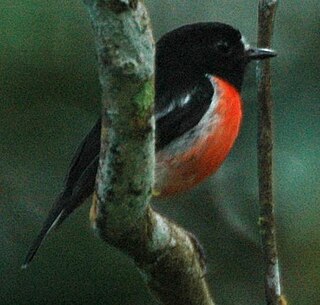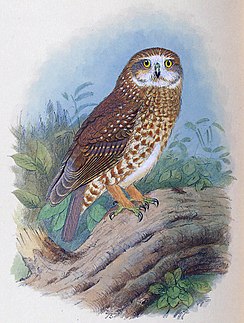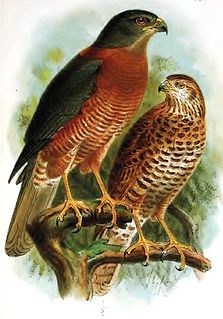
The Australian golden whistler, or golden whistler, is a species of bird found in forest, woodland, mallee, mangrove and scrub in Australia Most populations are resident, but some in south-eastern Australia migrate north during the winter. Its taxonomy is highly complex and remains a matter of dispute, with some authorities including as many as 59 subspecies of the golden whistler, while others treat several of these as separate species.

The olive whistler, or olivaceous whistler, is a species of bird in the family Pachycephalidae, the whistlers, that is native to southeastern Australia.

The Samoan whistler, also known as the yellow-fronted whistler, is a species of bird in the family Pachycephalidae. It is endemic to Samoa, where found in forest, plantations and gardens.

The Lord Howe silvereye, also known as the Lord Howe white-eye, Lord Howe Island white-eye or, locally, as the "Little Grinnell", is a small bird in the white-eye family, Zosteropidae. It is a subspecies of the silvereye, though sometimes considered a full species. It is endemic to Lord Howe Island in the Tasman Sea, part of New South Wales, Australia.

The Macquarie shag, Macquarie Island shag or Macquarie Island cormorant, is a marine cormorant native to Macquarie Island in the Southern Ocean, about halfway between Australia and Antarctica.

The Cocos buff-banded rail, Gallirallus philippensis andrewsi, is an endangered subspecies of the buff-banded rail endemic to the Cocos (Keeling) Islands, an Australian Offshore Territory in the central-eastern Indian Ocean. The local Cocos Malay name of the bird is ayam hutan.
The Macquarie rail, also known as the Macquarie Island rail, is an extinct subspecies of the buff-banded rail endemic to Macquarie Island, a subantarctic island that is part of the state of Tasmania, Australia. The holotype is in the collection of the Museum of New Zealand Te Papa Tongarewa.

The Pacific robin, is a red-breasted Australasian robin in the passerine bird genus Petroica found in Melanesia and Polynesia. It is similar in plumage to the scarlet robin of Australia, and until recently the two were considered conspecific until split in 1999 by Schodde and Mason. 14 subspecies of Pacific robin are currently recognised, and these subspecies display considerable variation in plumage, foraging preferences and habitat. The Norfolk robin was previously considered a subspecies of the Pacific robin, but is now considered a distinct species.
The Christmas thrush, ia a subspecies of the island thrush. It is endemic to Christmas Island, an Australian territory in the Indian Ocean.

The Norfolk boobook, also known as the Norfolk Island boobook, Norfolk Island owl or Norfolk Island morepork, was a bird in the true owl family endemic to Norfolk Island, an Australian territory in the Tasman Sea between Australia and New Zealand. It is an extinct subspecies of the morepork. However, although the taxon is extinct, its genes live on in the descendants of the hybrid offspring of the last female bird, which was sighted for the last time in 1996.

The Lord Howe fantail, also known as the Lord Howe Island fantail or fawn-breasted fantail, was a small bird in the fantail family, Rhipiduridae. It is an extinct subspecies of the New Zealand fantail. It was endemic to Lord Howe Island in the Tasman Sea, part of New South Wales, Australia.

The Lord Howe boobook, also known as the Lord Howe morepork, was a bird in the true owl family endemic to Lord Howe Island in the Tasman Sea, part of New South Wales, Australia. It is an extinct and little-known subspecies of the Southern boobook.

The Lord Howe currawong, Lord Howe Island currawong or Lord Howe pied currawong, is a large and mainly black passerine bird in the Artamidae family. It is endemic to Lord Howe Island in the Tasman Sea, part of New South Wales, Australia, and is a threatened subspecies of the pied currawong.

The Lord Howe golden whistler, also known as the Lord Howe whistler or Lord Howe Island golden whistler, and locally as the “robin” or “yellow robin”, is a small bird in the whistler family, Pachycephalidae. It is a subspecies of the Australian golden whistler that is endemic to Lord Howe Island in the Tasman Sea, part of New South Wales, Australia.

The Norfolk robin, also known as the Norfolk Island scarlet robin or Norfolk Island robin, is a small bird in the Australasian robin family, Petroicidae. It is endemic to Norfolk Island, an Australian territory in the Tasman Sea, between Australia and New Zealand.

The Christmas goshawk or Christmas Island goshawk is a bird of prey in the goshawk and sparrowhawk family Accipitridae. It is a threatened endemic of Christmas Island, an Australian territory in the eastern Indian Ocean.
The Christmas Island swiftlet, also known as the Christmas glossy swiftlet or the Christmas cave swiftlet, is a small bird in the swift family Apodidae. It is endemic to Christmas Island, an Australian territory in the eastern Indian Ocean. It was formerly commonly treated as a subspecies of the glossy swiftlet.
The Christmas emerald dove, also known as the Christmas green-winged pigeon, is a bird in the pigeon family, Columbidae. It is a distinctive subspecies of the common emerald dove that is endemic to Christmas Island, an Australian territory in the eastern Indian Ocean.
The Temotu whistler is a species of bird in the family Pachycephalidae, which is endemic to the Santa Cruz Islands of the Solomon Islands group. It was classified as a separate species in 2016 by the IOC. Two of its subspecies belonged previously to the former white-throated whistler and the nominate subspecies was a subspecies of the Melanesian Whistler.
The Rennell whistler is a species of bird in the family Pachycephalidae, which is endemic to the Rennell Island in the Solomon Islands. It was split from the Bismarck whistler by the IOC in 2016.
























